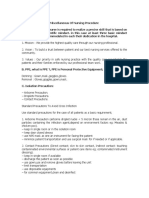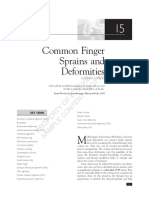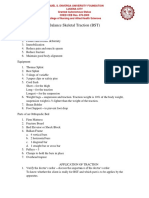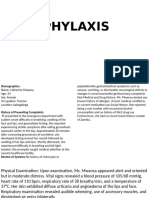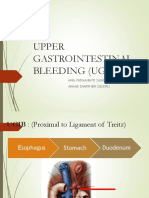Resting Splint Guidelines
Resting Splint Guidelines
Uploaded by
jzf13Copyright:
Available Formats
Resting Splint Guidelines
Resting Splint Guidelines
Uploaded by
jzf13Original Description:
Copyright
Available Formats
Share this document
Did you find this document useful?
Is this content inappropriate?
Copyright:
Available Formats
Resting Splint Guidelines
Resting Splint Guidelines
Uploaded by
jzf13Copyright:
Available Formats
North-West Rheumatology Occupational Therapy Research Group Recommendations for Resting Splint provision
Developed by: The North-West Rheumatology OT Research Group Recommendation developers: Charlie Laver* (Pennine Musculoskeletal Partnership, Oldham) Alison Hammond*, Jo Mellson,* Yeliz Greenhill (University of Salford), Lynette Bowler, Jan Colclough, Nicky Walker (Mid Cheshire Hospitals NHS Foundation Trust) Karen Crosby (Central Manchester University Hospitals NHS Foundation Trust) Mary Dooley (Southport & Ormskirk Hospital NHS Trust) Sandra Hargreaves (East Cheshire NHS Trust), Yvonne Hough (Five Boroughs Partnership NHS Foundation Trust), Angela Jacklin (Stockport NHS Foundation Trust), Helen Rogerson (Salford Royal NHS Foundation Trust) Annette Sands (Wrightington, Wigan and Leigh NHS Foundation Trust) Sarah Whitford (Countess of Chester Hospital NHS Foundation Trust
* Resting splint survey and recommendations co-ordinators and focus group leads.
NW Rheumatology OT Resting Splint Recommendations v1 16.7.12
Page 1
These recommendations are intended to help standardise practice, particularly for those less experienced in splint provision. These consensus recommendations were developed based on review of the evidence, results of a resting splint practice survey amongst North-West Rheumatology Occupational Therapists and expert clinical opinion.
1.
The purpose of resting splints should be explained prior to obtaining informed consent for splint provision. This explanation should include:
a. the aims of OT b. explanation of the client�s condition: facts and effects of the disease on the hands. Commonly, the condition will be rheumatoid arthritis (RA) or inflammatory arthritis (IA) c. Identifying and explaining the symptoms experienced by the person with arthritis. Linking the person�s symptoms to the clinical rationale for resting splint provision (eg to reduce hand pain and swelling). The decision to provide the splint is then client-led, ie if a clinical need has been determined following assessment, it is the person�s choice whether to be provided with the splint. Verbal consent should be obtained and recorded in the person�s OT record.
2.
Assessment for resting splints should include (in priority order):
a. Hand pain (night and day) � using Visual Analogue Scales and discussion about the nature and location* of hand pain b. Joint swelling/synovitis � observation (and palpation if necessary) recording the degree of swelling on a hand chart c. Hand position on waking � discussion d. Sleep disturbance � discussion e. Joint changes/ deformities/ contractures � observation and recording on hand chart f. Range of Movement� either visual estimation or goniometry g. Other hand conditions (eg carpal tunnel syndrome, osteoarthritis) � client report and assessment as appropriate h. Optionally: digital photography using standardised positions: bilateral dorsal and volar views, with wrists in neutral and fingers in extension. Other views (medial, lateral and/or full finger flexion) as required. * Note: if the patient has wrist pain only, consider providing a wrist splint for rest rather than a resting splint.
NW Rheumatology OT Resting Splint Recommendations v1 16.7.12
Page 2
3.
Why resting splints should not be provided in IA, early or established RA:
a. Limited psychological acceptance of the condition by the person b. c. d. e. f. g. Poor skin condition Poor sight affecting ability to don and doff correctly (unless a carer is available to assist) Severe fixed flexion contractures preventing splint fitting (even for serial splinting) Poor cognitive function affecting ability to understand correct wear Person states s/he will not wear the resting splint Inability to don/doff independently during the night (eg if regular toileting or childcare needs, unless a carer is available to assist). A review appointment may be appropriate later to determine if the situation has changed.
4.
Resting splint design:
a. Splint patterni. usually the pattern�s thumb support section is drawn downwards from the palmar section. This ensures thumb opposition can be achieved. ii. If greater CMC support is required and/or the person is unable to tolerate full thumb opposition then a �mitten� pattern may be used. See Appendix 1 for patterns. b. Position � i. Wrist � 10-20 extension: if the person has carpal tunnel syndrome, the wrist should be in neutral. ii. MCPs � 25-40 flexion iii. PIPs � 15-20 flexion iv. DIPS � 5-10 flexion v. Thumb � opposition to index finger maintaining an �open C� position with IPJ in slight flexion vi. Forearm: usually pronation but can be midline particularly if the patient has shoulder problems or finds this more comfortable vii. All hand arches should be maintained. These are optimum positions but can be modified according to the patient�s range of movement and for comfort. See Appendix 2 for examples of resting splint positioning. c. Splint length: three-quarters of the forearm; the minimum is half length
d. Strap placement � straps should not be placed over a joint if the joint is very swollen or the person is unable to tolerate this. These are located at: a. The proximal end of the splint b. at the wrist: consider using a diagonal strap if the ulnar styloid is painful c. distal to the MCPJs. d. Optionally over the thumb (client�s choice). A cushioned strap (of any make) is preferable to Velcro.
NW Rheumatology OT Resting Splint Recommendations v1 16.7.12
Page 3
e. Material choice: consider the following properties when selecting splint material: i. Conformability ii. Durability iii. The degree of rigidity (ie the degree required by the client) iv. Lighter weight v. Allowing for minor adjustments vi. Ease of use vii. The length of working time (ie sufficient for correct moulding/ positioning and therapist�s skill level) viii. Cosmetically acceptable ix. Ease of cleaning x. Cost A range of materials is needed to meet clients� needs and choices. Provide stockinette or Tubifast for additional comfort to be worn under the splint, if necessary.
5.
Resting splint instruction sheets.
An instruction sheet must be provided to supplement verbal instructions. These must adhere to Trust policy (ie standard content and standard of any Trust information such as contact details, review date; reading age) and approved by the Trust, if required. The following should be included: a. Why the resting splint is provided: i. to reduce pain; ii. to rest and support joints; iii. and to maintain and improve function. iv. The sheet should not state it will prevent deformity*. *Silva et al (2008), NAROT (2003): there is no evidence that resting splints help to prevent deformity.
b. When and how to wear the resting splint: i. include tick boxes for the therapist to specify if the splint is for day and/or night wear. ii. Include a box in which additional information can be written to individualise the splint instruction (eg wear for up to 2 hours during the day; wear at night etc, as required to meet the client�s needs) During the first few days or week only: gradually increase duration of splint wear during the day (for up to 2 hours) before wearing all night, in order to i) check for any changes in hand appearance or discomfort and ii) to get used to wearing the splint. Once used to wearing the splint, wear it during the night and/ or day, as recommended by the therapist. Wear during a flare and for up to 6 weeks following a flare When no longer experiencing hand symptoms, discontinue wearing. Retain the splint for future use if necessary. Hand range of movement exercises should be performed daily on removal of the splint.
iii.
iv. v. vi.
vii.
NW Rheumatology OT Resting Splint Recommendations v1 16.7.12
Page 4
c.
Precautions: Check for changes in: i. ii. iii. appearance of the hand (eg marking, redness, rash) sensation of the hand (pins and needles or numbness) If there are any changes in hand appearance, sensation, symptoms or discomfort caused by the resting splint, it should be removed. Contact the OT department as soon as possible to have the splint reviewed.
d. Splint care i. Cleaning: wash in cool, soapy water and rinse in cold water; use wet wipes; or a cool damp cloth. ii. Keep away from heat � do not place on a radiator or in direct sunlight iii. Do not alter the splint� contact the OT department if any changes are required.
6.
Resting splints should be used in conjunction with a hand exercise programme
a. The therapist should teach a range of movement hand exercise programme. . b. Hand exercises should be performed daily on splint removal c. A hand exercise instruction sheet should be provided.
7.
Follow-up evaluation.
a. Short-term review is essential: preferably completed face-to-face. This should include as a minimum: i. Confirming that the person is wearing the splint as advised; ii. if the person reports, or therapist identifies, any problems eg redness, skin marking, sensation changes; iii. whether the person reports obtaining pain relief. This should be measured using a pain VAS (related to pain experienced during the day and/or night as applicable to the recommended splint wearing regimen; iv. and the person�s views about the splint�s effects. v. All clients should then be informed to contact OT in future if: they encounter any problems with the resting splint; any splint modifications are required; or their hands change and the splint no longer fits.
b. Long term review may be conducted at annual reviews or if/when the person attends for future appointments to check the splint is still fitting and of benefit.
8. Discharge a. The person is discharged after the first review appointment if no problems are identified. b. Discharge letters should follow Trust policy Resting splint provision On average, 25% (inter-quartile range: 10-35%) of clients with RA, who are referred to Rheumatology OTs in the North-West region, are provided with resting splints.
NW Rheumatology OT Resting Splint Recommendations v1 16.7.12
Page 5
Appendix 1: Resting Splint Patterns There are two patterns commonly used. Pattern 1 ensures the thumb is splinted in opposition. Pattern 2 may be used if the client finds a mid-abduction/opposition position is more comfortable. Pattern 1: Thumb opposition
NW Rheumatology OT Resting Splint Recommendations v1 16.7.12
Page 6
Pattern instructions (both designs) Both patterns: Draw around the hand, making sure the fingers are positioned comfortably (not too ad-or abducted). Use a thin pen, holding it at 90 degrees to the paper, to ensure the pattern is as accurate as possible. Mark on the MCPJs, thumb IPJ, wrist and first web space Draw a border around the hand shape of approximately cm. Optionally, an additional border extension can be drawn on the medial (5th finger) side (see Pattern 2: �mitten pattern�). Flare the outline from the wrist level downwards: Measure two/thirds the length of the forearm, and draw the pattern so that the forearm section will be this long. The pattern/ splint should be half the circumference of the forearm (to provide strength to the splint and distribute pressure evenly). Pattern 1: Thumb down: Distances a and b help in drawing the thumb section On the pattern, the thumb section starts from the first web space. The width �a,� ie from the first web space to the thumb IPJ, will be the width of the thumb section. . The length �b,� ie from the end of the thumb to the mid-point of first webspace to thumb IPJ, will be the length of the thumb section. When drawing the pattern, curve around the thenar eminence Both patterns: Try the pattern on the patient noting any alterations required
NW Rheumatology OT Resting Splint Recommendations v1 16.7.12
Page 7
Pattern 2: Mitten pattern
NW Rheumatology OT Resting Splint Recommendations v1 16.7.12
Page 8
Appendix 2: Examples of Resting Splint designs and strap positioning a) Forearm in pronation; straight wrist strap; thumb opposition (Pattern1: thumb opposition)
b) Forearm in pronation; diagonal wrist strap; thumb in position of comfort (Pattern 2: mitten pattern).
c) Forearm in midline; straight wrist strap; thumb in opposition (Pattern 1; pull the forearm/wrist section round to the ulnar border of the forearm when moulding)
NW Rheumatology OT Resting Splint Recommendations v1 16.7.12
Page 9
References: Mellson J, Laver C, Hammond A (2011). Resting splint provision: a survey of practice within the NW COTSS Rheumatology group. Journal of Rheumatology Occupational Therapy 26(2):3-8 National Association of Rheumatology Occupational Therapists (NAROT: 2003) Occupational Therapy Clinical Guidelines for Rheumatology. College of Occupational Therapists: London. Silva AC, Jones A, Silva PG, Natour J (2008) Effectiveness of a night-time hand positioning splint in rheumatoid arthritis: a randomised controlled trial. Journal of Rehabilitation Medicine 40:749-754.
NW Rheumatology OT Resting Splint Recommendations v1 16.7.12
Page 10
You might also like
- Nursing Skill 1-9 Using RestraintsDocument9 pagesNursing Skill 1-9 Using RestraintsHui ChenNo ratings yet
- Critical Thinking Nursing Care LippincotsDocument35 pagesCritical Thinking Nursing Care Lippincotseric100% (1)
- CLO 4 Study GuideDocument2 pagesCLO 4 Study GuideTati KimNo ratings yet
- Caring of Client With Immobilization DevicesDocument6 pagesCaring of Client With Immobilization DevicesJmarie Brillantes PopiocoNo ratings yet
- Adm Traction PDFDocument10 pagesAdm Traction PDFbitha p bNo ratings yet
- Hurst 10 - Orthopedics - Docx Version 1Document3 pagesHurst 10 - Orthopedics - Docx Version 1Winnie TsaiNo ratings yet
- Applying Splint - CheklistDocument3 pagesApplying Splint - CheklistAh AlshaibaniNo ratings yet
- Orthopedic Problem and ManagementDocument42 pagesOrthopedic Problem and Managementjosephabram051590No ratings yet
- How Do You Ensure That The Patient Is Not Wrongfully Fitted With The Wrong Denture After?Document2 pagesHow Do You Ensure That The Patient Is Not Wrongfully Fitted With The Wrong Denture After?JOEL MWANGINo ratings yet
- Applying RestarintsDocument2 pagesApplying RestarintsCarol Neng CalupitanNo ratings yet
- Applying Restraint Nursing SkillDocument2 pagesApplying Restraint Nursing SkillEiichiro BertoNo ratings yet
- Restraints StudentsDocument3 pagesRestraints StudentsMaggay LarsNo ratings yet
- Amputation and ProsthesisDocument5 pagesAmputation and Prosthesisaishp2897No ratings yet
- Chapter 8 WSDocument2 pagesChapter 8 WSpavanvkottiNo ratings yet
- Common Finger Sprains and Deformities PDFDocument19 pagesCommon Finger Sprains and Deformities PDFOmar Najera de GonzalezNo ratings yet
- Skin TractionDocument14 pagesSkin TractionAnis IzzatiNo ratings yet
- ODocument37 pagesOyaraNo ratings yet
- Care of Client With Immobilization DevicesDocument8 pagesCare of Client With Immobilization DevicesJan Federick BantayNo ratings yet
- 1.教案 the Knee Joint Aspiration (Knee)Document8 pages1.教案 the Knee Joint Aspiration (Knee)林宜璇No ratings yet
- Applying A SlingDocument2 pagesApplying A SlingHoney Que BullivantNo ratings yet
- Clinical Protocol For Flexor Tendon Early Mobilization - Modified Duran MethodDocument3 pagesClinical Protocol For Flexor Tendon Early Mobilization - Modified Duran MethodAmit GoyalNo ratings yet
- NCLEX Review Questions Musculoskeletal SystemDocument12 pagesNCLEX Review Questions Musculoskeletal SystemManny100% (8)
- AmputationDocument17 pagesAmputationxsharkzzxNo ratings yet
- Bandage Wrapping - Bandaging Techniques: First AidDocument6 pagesBandage Wrapping - Bandaging Techniques: First AidangelyaniNo ratings yet
- Gentle Threads Interference Screws BIOMETDocument6 pagesGentle Threads Interference Screws BIOMETcicazNo ratings yet
- WORKSHEET For Unit 14 On PEDIATRIC MUSCULOSKELETAL DISORDERSDocument14 pagesWORKSHEET For Unit 14 On PEDIATRIC MUSCULOSKELETAL DISORDERScorisNo ratings yet
- Table 17.2: Instrument Which Are Useful For Fitting and Adjusting Removable ApplianceDocument6 pagesTable 17.2: Instrument Which Are Useful For Fitting and Adjusting Removable AppliancegloeddessNo ratings yet
- Med 2047 - Dewit Chapter Pretests Directions: Answer The Following Multiple-Choice QuestionsDocument9 pagesMed 2047 - Dewit Chapter Pretests Directions: Answer The Following Multiple-Choice QuestionsMarcelyn Chupoco CataligNo ratings yet
- Caring For A CastDocument39 pagesCaring For A CastGrape JuiceNo ratings yet
- Restraining Procedure: General Principles For Use of RestraintsDocument10 pagesRestraining Procedure: General Principles For Use of RestraintsHardeep Kaur100% (1)
- RestraintsDocument16 pagesRestraintsSowjanyaNo ratings yet
- Nursing Responsibilities in The Care of Casts Traction FixatorsDocument20 pagesNursing Responsibilities in The Care of Casts Traction FixatorsBasmah A. AdompingNo ratings yet
- Amputation NclexDocument3 pagesAmputation NclexCharisse TaylanNo ratings yet
- IFU HemoclipDocument11 pagesIFU Hemoclipnguyenngoc291095No ratings yet
- Tactical Field Care 2a: (Based On TCCC-MP Guidelines 180801)Document35 pagesTactical Field Care 2a: (Based On TCCC-MP Guidelines 180801)Luis-alfredo Perez Bolde HernandezNo ratings yet
- 2011 Medical Surgical Hesi RemediationDocument69 pages2011 Medical Surgical Hesi RemediationTheMench67% (3)
- Hip Replacement - Physiotherapy After Total Hip ReplacementDocument11 pagesHip Replacement - Physiotherapy After Total Hip ReplacementShamsuddin HasnaniNo ratings yet
- TRACTION LavlyDocument9 pagesTRACTION Lavlylabsky_evol100% (1)
- Medical-Surgical Nursing Assessment and Management of Clinical Problems 9e Chapter 63Document16 pagesMedical-Surgical Nursing Assessment and Management of Clinical Problems 9e Chapter 63sarasjunkNo ratings yet
- Traction Application Nursing ManagementDocument17 pagesTraction Application Nursing ManagementLatrell GelacioNo ratings yet
- Tha ProtocolDocument7 pagesTha ProtocolJosephine SaesariaNo ratings yet
- Knee Athroscopic Surgery Complete RehabDocument8 pagesKnee Athroscopic Surgery Complete RehabdiskraNo ratings yet
- HLTENN004 Assignment - NursingDocument4 pagesHLTENN004 Assignment - NursingJulianneTintNo ratings yet
- NCM 106 Skills - Handout - 01 - Application of RestraintsDocument12 pagesNCM 106 Skills - Handout - 01 - Application of RestraintsMj BrionesNo ratings yet
- NCP BkaDocument4 pagesNCP BkaKeeshia CesnerosNo ratings yet
- Pelvic Traction SlingDocument3 pagesPelvic Traction SlingryanNo ratings yet
- Checkout of Lower Limb OrthosesDocument21 pagesCheckout of Lower Limb OrthosesShweta Jethwani100% (2)
- Physiotherapy Rehabilitation Guidelines - Knee ArthrosDocument7 pagesPhysiotherapy Rehabilitation Guidelines - Knee ArthrosmatameaNo ratings yet
- MuscoskeletalDocument6 pagesMuscoskeletalFilipino Nurses Central100% (2)
- 3 Modalities (Traction, Fixator and Surgery)Document57 pages3 Modalities (Traction, Fixator and Surgery)Maria Lynne ParambitaNo ratings yet
- Triangular Fibrocartilage Complex (TFCC) Repair and RehabilitationDocument5 pagesTriangular Fibrocartilage Complex (TFCC) Repair and RehabilitationmksayshiNo ratings yet
- Surgery - Care of Casts and TractionsDocument7 pagesSurgery - Care of Casts and TractionsMaria Eleni ÖNo ratings yet
- Application of Roller-Elastic BandageDocument6 pagesApplication of Roller-Elastic Bandagekuro hanabusaNo ratings yet
- NCM 112 Lesson3Document6 pagesNCM 112 Lesson3Trisha LopezNo ratings yet
- NCP OsteosarcomaDocument6 pagesNCP OsteosarcomaNiksNo ratings yet
- Balance Skeletal TractionDocument4 pagesBalance Skeletal TractionIris BalinoNo ratings yet
- My TKR: One Patient's Experience With Total Knee ReplacementFrom EverandMy TKR: One Patient's Experience With Total Knee ReplacementRating: 5 out of 5 stars5/5 (1)
- Keys to Successful Orthotopic Bladder SubstitutionFrom EverandKeys to Successful Orthotopic Bladder SubstitutionUrs E. StuderNo ratings yet
- EMERGENCY CARE FOR BEGINNERS: Essential First Aid Techniques and Tips (2024)From EverandEMERGENCY CARE FOR BEGINNERS: Essential First Aid Techniques and Tips (2024)No ratings yet
- Senior Project Proposal: Katherine Hlavac Spring 2011Document21 pagesSenior Project Proposal: Katherine Hlavac Spring 2011Kathy HlavacNo ratings yet
- Diagnosing Acute Monoarthritis in Adults PDFDocument8 pagesDiagnosing Acute Monoarthritis in Adults PDF蔡季霖No ratings yet
- Comparison of STEMI and NSTEMI Patients in The Emergency DepartmentDocument4 pagesComparison of STEMI and NSTEMI Patients in The Emergency DepartmentazizhaNo ratings yet
- Newborn ScreeningDocument2 pagesNewborn ScreeningSydelle GravadorNo ratings yet
- Jurnal Internasional Draft 3Document8 pagesJurnal Internasional Draft 3thenytirtaNo ratings yet
- Primary Amebic Meningoencephalitis (PAM)Document3 pagesPrimary Amebic Meningoencephalitis (PAM)Nur SeftihaniNo ratings yet
- Hepatobiliary System Note PDFDocument13 pagesHepatobiliary System Note PDFMohd Syaiful Mohd ArisNo ratings yet
- Antibiotic Prophylaxis in Surgery: A National Clinical GuidelineDocument78 pagesAntibiotic Prophylaxis in Surgery: A National Clinical GuidelineDimas RfNo ratings yet
- Krishna Reddy - Tumors of External EarDocument19 pagesKrishna Reddy - Tumors of External EarSiva ramaNo ratings yet
- A Fracture of The Distal Radius or UlnaDocument3 pagesA Fracture of The Distal Radius or UlnaSweetie StarNo ratings yet
- New Drug Regulatory Program ModernizationDocument41 pagesNew Drug Regulatory Program ModernizationHel B IlomoNo ratings yet
- By:Hend Eldeeb: Complete The Following SentencesDocument6 pagesBy:Hend Eldeeb: Complete The Following SentencesAhmed J AlhindaweNo ratings yet
- RRLDocument3 pagesRRLKevin M. VillacorteNo ratings yet
- ANAPHYLAXIS PresentationDocument26 pagesANAPHYLAXIS PresentationMweembe HabukaliNo ratings yet
- 4 CVPDocument2 pages4 CVPAudrey Ann AcobNo ratings yet
- Shalakya Tantra-2 Short NotesDocument202 pagesShalakya Tantra-2 Short NotesvishalpattarNo ratings yet
- Cee Based Model Exam Bhadra 30, 2080, Saturday Page 1 of 10Document6 pagesCee Based Model Exam Bhadra 30, 2080, Saturday Page 1 of 10Kailash KhatriNo ratings yet
- LP UapDocument18 pagesLP UapHat MutisalNo ratings yet
- Secondary Clotting DisordersDocument34 pagesSecondary Clotting DisordersLyra Dennise LlidoNo ratings yet
- Phytotherapy On CancerDocument21 pagesPhytotherapy On CancerSiddhendu Bhattacharjee100% (1)
- Traumatic Brain Injury - Epidemiology, Classification, and Pathophysiology - UpToDateDocument19 pagesTraumatic Brain Injury - Epidemiology, Classification, and Pathophysiology - UpToDateValentina bustamanteNo ratings yet
- UGIBDocument34 pagesUGIBChe Ainil ZainodinNo ratings yet
- 6 - 7 ConjunctivaDocument16 pages6 - 7 ConjunctivaMariam QaisNo ratings yet
- Shalu Bathla - Chronic PeriodontitisDocument6 pagesShalu Bathla - Chronic PeriodontitisFerdinan PasaribuNo ratings yet
- My One Night Stand With CancerDocument5 pagesMy One Night Stand With CancerSydney RoslinNo ratings yet
- Ankle Sprains and The AthleteDocument3 pagesAnkle Sprains and The AthleteTeoNo ratings yet
- Guidelines For UrologyDocument91 pagesGuidelines For UrologyAruna HarikrishnanNo ratings yet
- Cyriax - Spine: by DR. Akshay A. Chougule (PT) Orthopaedic Manual TherapistDocument44 pagesCyriax - Spine: by DR. Akshay A. Chougule (PT) Orthopaedic Manual TherapistAishwarya Shah100% (2)
- Pressure Injuries and The Aging Skin - NSG 325 - Abigail PowersDocument8 pagesPressure Injuries and The Aging Skin - NSG 325 - Abigail Powersapi-591508557No ratings yet
- National - Pain - Relief - Poster - Including - Child - Doses - v29Document2 pagesNational - Pain - Relief - Poster - Including - Child - Doses - v29I Made AryanaNo ratings yet

